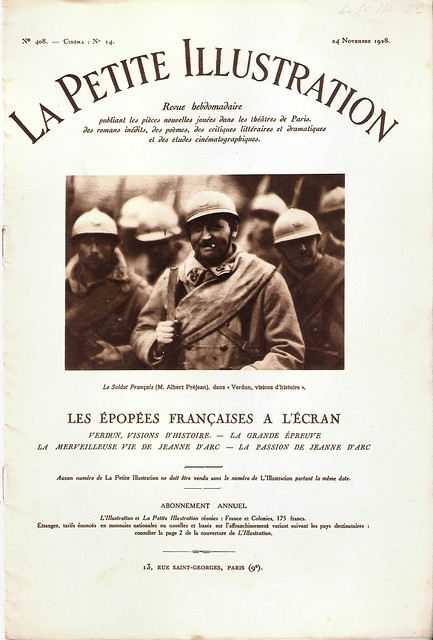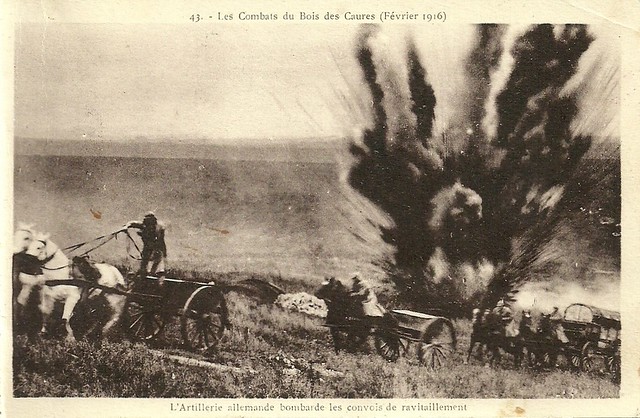In two months it will be 2014 and it will be 100 years ago that the First World War started. European Film Gateway 1914 is an interesting digitisation project focusing on films and non-film material from and related to World War I. 26 partners, among them 21 European film archives, are digitalising 661 hours of film and ca. 5.600 film-related documents on the theme of the First World War. And it's all free accessible, so check it out.
The French silent film Verdun, visions d'histoire (Léon Poirier, 1928) is a dramatized account of the Battle of Verdun (1916), a key World War I battle. French troops, fighting alone and often in desperate hand-to-hand combat, had to halt the German advance at all costs. The film uses newsreel footage, director Léon Poirier's own highly realistic reconstructions of the conflict and some little dramatic scenes which add a thread of personal interest to the events. On European Film Gateway 1914, there is only a poster of Verdun, visions d'histoire yet. Here at EFSP, we present you the postcards.
Image may be NSFW.
Clik here to view.
French postcard by Editions Cinémagazine, no. 550. Photo: Pierre Nay as The Son in Verdun, visions d'histoire (Léon Poirier, 1928).
Director Léon Poirier tells Verdun, visions d'histoire from both sides. The film is surprisingly sympathetic to the German point of view, considering when it was made.
Poirier's pacifist stance is revealed in several moments, notably in one scene when two angels descend onto the battlefield and extract the souls of two soldiers, one German and one French, and place them together on a stretcher which they carry up to heaven.
The re-enacted battle sequences, place the viewer in the midst of the horror, crawling across no-man's-land, cowering in fox-holes, or being blown apart in trenches. The countryside is shown as a moonscape of craters and splintered trees.
The film features newly filmed material, but also features much archive footage of Emperor Wilhelm II and German marches. It also features maps to illustrate the battle.
Image may be NSFW.
Clik here to view.
French postcard by Editions Cinémagazine, no. 554. Photo: José Davert as The Old Farmer in Verdun, visions d'histoire (Léon Poirier, 1928).
Image may be NSFW.
Clik here to view.
French postcard by Editions Cinémagazine, no. 555. Photo: publicity still of Maurice Schutz as The Old Marshal in Verdun, visions d'histoire (Léon Poirier, 1928).
Image may be NSFW.
Clik here to view.
French postcard by Editions Cinemagazine, no. 556. Photo: Thomy Bourdelle as The German officer in Verdun, visions d'histoire (Léon Poirier, 1928).
Image may be NSFW.
Clik here to view.
French postcard by A.N., Paris, no. 344. Photo: Alban. Suzanne Bianchetti as The Wife in Verdun, visions d'histoire (Léon Poirier, 1928).
Verdun, visions d'histoire is filmed on location in Verdun and surroundings. The scene in which the Intellectual (Antonin Artaud) dies, is actually filmed in a real shell hole. Remains of a human arm were found with a ID tag on which the filmmakers could just make out: "Fulle... 1916" (Class of 1916).
For the Bois des Caures scene many actual veterans are used. Among them are Lieutenant Robin and captain Vantroys, who responded to Léon Poirier's call to participate in the film. They are playing themselves in the film.
According to Poirier, the entire cast and crew of the film were made up of Great War veterans. The only exceptions were the female actresses, like Suzanne Bianchetti and Jeanne Marie-Laurent, and the older actors such as André Nox and Maurice Schutz. Antonin Artaud also wasn't a veteran.
The premiere of the film took place in Paris in November 1928, at the Opéra Garnier, to celebrate the 10 years of the armistice.
In 1931, a re-edited sound version of Verdun, souvenirs d'histoire was released with some re-shot scenes using different actors.
Many prints of the film were lost over the years and only very few prints were available. the best existing print was found in Moscow: stolen from France by the Nazis, then grabbed by the Russians at the end of the war. A restoration by the Cinémathèque de Toulouse of this print of the original silent version was issued on DVD in 2006.
Image may be NSFW.
Clik here to view.![La Petite Illustration, Verdun]()
Cover of the French magazine La Petite Illustration, no. 408, 18 September 1928. The picture shows Albert Préjean in the film Verdun, visions d'histoire (Léon Poirier, 1928).
Image may be NSFW.
Clik here to view.![Verdun]()
French postcard by Editions V.G., no. 32. Verdun, visions d'histoire (Léon Poirier, 1928) was released a decade after the end of the First World War.
Image may be NSFW.
Clik here to view.![Verdun]()
French postcard by Editions V.G., no. 43.
Image may be NSFW.
Clik here to view.![Verdun]()
French postcard by Editions V.G., no. 44.
Image may be NSFW.
Clik here to view.![Verdun]()
French postcard by Editions V.G., no. 37.
Image may be NSFW.
Clik here to view.![Verdun, Visions d'histoire shown in France]()
French postcard by Photo-Edit. E. Mignon, Nangis, Seine-et-Marne, no. 1021. The film Verdun, visions d'histoire (Léon Poirier, 1928) shown in Melun (Seine et Marne district), which is some 50 km from Paris.
Sources: Wikipedia (French) and IMDb.
The French silent film Verdun, visions d'histoire (Léon Poirier, 1928) is a dramatized account of the Battle of Verdun (1916), a key World War I battle. French troops, fighting alone and often in desperate hand-to-hand combat, had to halt the German advance at all costs. The film uses newsreel footage, director Léon Poirier's own highly realistic reconstructions of the conflict and some little dramatic scenes which add a thread of personal interest to the events. On European Film Gateway 1914, there is only a poster of Verdun, visions d'histoire yet. Here at EFSP, we present you the postcards.
Image may be NSFW.
Clik here to view.

French postcard by Editions Cinémagazine, no. 550. Photo: Pierre Nay as The Son in Verdun, visions d'histoire (Léon Poirier, 1928).
Crawling Across No-man's-land
Director Léon Poirier tells Verdun, visions d'histoire from both sides. The film is surprisingly sympathetic to the German point of view, considering when it was made.
Poirier's pacifist stance is revealed in several moments, notably in one scene when two angels descend onto the battlefield and extract the souls of two soldiers, one German and one French, and place them together on a stretcher which they carry up to heaven.
The re-enacted battle sequences, place the viewer in the midst of the horror, crawling across no-man's-land, cowering in fox-holes, or being blown apart in trenches. The countryside is shown as a moonscape of craters and splintered trees.
The film features newly filmed material, but also features much archive footage of Emperor Wilhelm II and German marches. It also features maps to illustrate the battle.
Image may be NSFW.
Clik here to view.

French postcard by Editions Cinémagazine, no. 554. Photo: José Davert as The Old Farmer in Verdun, visions d'histoire (Léon Poirier, 1928).
Image may be NSFW.
Clik here to view.

French postcard by Editions Cinémagazine, no. 555. Photo: publicity still of Maurice Schutz as The Old Marshal in Verdun, visions d'histoire (Léon Poirier, 1928).
Image may be NSFW.
Clik here to view.

French postcard by Editions Cinemagazine, no. 556. Photo: Thomy Bourdelle as The German officer in Verdun, visions d'histoire (Léon Poirier, 1928).
Image may be NSFW.
Clik here to view.

French postcard by A.N., Paris, no. 344. Photo: Alban. Suzanne Bianchetti as The Wife in Verdun, visions d'histoire (Léon Poirier, 1928).
Filmed In A Real Shell Hole
Verdun, visions d'histoire is filmed on location in Verdun and surroundings. The scene in which the Intellectual (Antonin Artaud) dies, is actually filmed in a real shell hole. Remains of a human arm were found with a ID tag on which the filmmakers could just make out: "Fulle... 1916" (Class of 1916).
For the Bois des Caures scene many actual veterans are used. Among them are Lieutenant Robin and captain Vantroys, who responded to Léon Poirier's call to participate in the film. They are playing themselves in the film.
According to Poirier, the entire cast and crew of the film were made up of Great War veterans. The only exceptions were the female actresses, like Suzanne Bianchetti and Jeanne Marie-Laurent, and the older actors such as André Nox and Maurice Schutz. Antonin Artaud also wasn't a veteran.
The premiere of the film took place in Paris in November 1928, at the Opéra Garnier, to celebrate the 10 years of the armistice.
In 1931, a re-edited sound version of Verdun, souvenirs d'histoire was released with some re-shot scenes using different actors.
Many prints of the film were lost over the years and only very few prints were available. the best existing print was found in Moscow: stolen from France by the Nazis, then grabbed by the Russians at the end of the war. A restoration by the Cinémathèque de Toulouse of this print of the original silent version was issued on DVD in 2006.
Image may be NSFW.
Clik here to view.

Cover of the French magazine La Petite Illustration, no. 408, 18 September 1928. The picture shows Albert Préjean in the film Verdun, visions d'histoire (Léon Poirier, 1928).
Image may be NSFW.
Clik here to view.

French postcard by Editions V.G., no. 32. Verdun, visions d'histoire (Léon Poirier, 1928) was released a decade after the end of the First World War.
Image may be NSFW.
Clik here to view.

French postcard by Editions V.G., no. 43.
Image may be NSFW.
Clik here to view.

French postcard by Editions V.G., no. 44.
Image may be NSFW.
Clik here to view.

French postcard by Editions V.G., no. 37.
Image may be NSFW.
Clik here to view.

French postcard by Photo-Edit. E. Mignon, Nangis, Seine-et-Marne, no. 1021. The film Verdun, visions d'histoire (Léon Poirier, 1928) shown in Melun (Seine et Marne district), which is some 50 km from Paris.
Sources: Wikipedia (French) and IMDb.